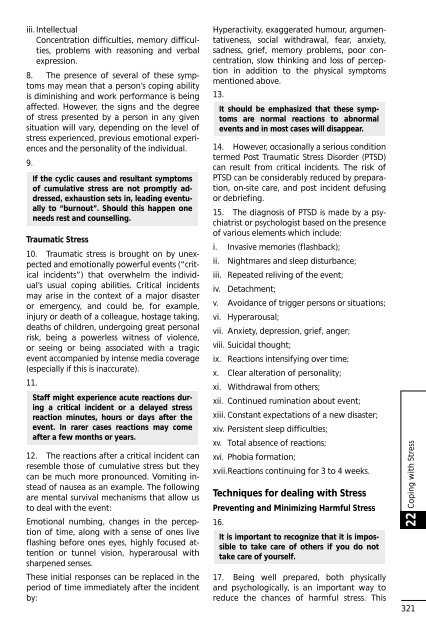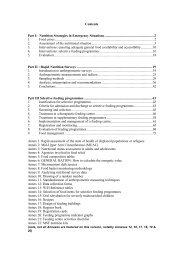UNHCR Handbook for Emergencies - UNHCR eCentre
UNHCR Handbook for Emergencies - UNHCR eCentre
UNHCR Handbook for Emergencies - UNHCR eCentre
You also want an ePaper? Increase the reach of your titles
YUMPU automatically turns print PDFs into web optimized ePapers that Google loves.
iii. Intellectual<br />
Concentration difficulties, memory difficulties,<br />
problems with reasoning and verbal<br />
expression.<br />
8. The presence of several of these symptoms<br />
may mean that a person’s coping ability<br />
is diminishing and work per<strong>for</strong>mance is being<br />
affected. However, the signs and the degree<br />
of stress presented by a person in any given<br />
situation will vary, depending on the level of<br />
stress experienced, previous emotional experiences<br />
and the personality of the individual.<br />
9.<br />
If the cyclic causes and resultant symptoms<br />
of cumulative stress are not promptly addressed,<br />
exhaustion sets in, leading eventually<br />
to “burnout”. Should this happen one<br />
needs rest and counselling.<br />
Traumatic Stress<br />
10. Traumatic stress is brought on by unexpected<br />
and emotionally powerful events (“critical<br />
incidents”) that overwhelm the individual’s<br />
usual coping abilities. Critical incidents<br />
may arise in the context of a major disaster<br />
or emergency, and could be, <strong>for</strong> example,<br />
injury or death of a colleague, hostage taking,<br />
deaths of children, undergoing great personal<br />
risk, being a powerless witness of violence,<br />
or seeing or being associated with a tragic<br />
event accompanied by intense media coverage<br />
(especially if this is inaccurate).<br />
11.<br />
Staff might experience acute reactions during<br />
a critical incident or a delayed stress<br />
reaction minutes, hours or days after the<br />
event. In rarer cases reactions may come<br />
after a few months or years.<br />
12. The reactions after a critical incident can<br />
resemble those of cumulative stress but they<br />
can be much more pronounced. Vomiting instead<br />
of nausea as an example. The following<br />
are mental survival mechanisms that allow us<br />
to deal with the event:<br />
Emotional numbing, changes in the perception<br />
of time, along with a sense of ones live<br />
flashing be<strong>for</strong>e ones eyes, highly focused attention<br />
or tunnel vision, hyperarousal with<br />
sharpened senses.<br />
These initial responses can be replaced in the<br />
period of time immediately after the incident<br />
by:<br />
Hyperactivity, exaggerated humour, argumentativeness,<br />
social withdrawal, fear, anxiety,<br />
sadness, grief, memory problems, poor concentration,<br />
slow thinking and loss of perception<br />
in addition to the physical symptoms<br />
mentioned above.<br />
13.<br />
It should be emphasized that these symptoms<br />
are normal reactions to abnormal<br />
events and in most cases will disappear.<br />
14. However, occasionally a serious condition<br />
termed Post Traumatic Stress Disorder (PTSD)<br />
can result from critical incidents. The risk of<br />
PTSD can be considerably reduced by preparation,<br />
on-site care, and post incident defusing<br />
or debriefing.<br />
15. The diagnosis of PTSD is made by a psychiatrist<br />
or psychologist based on the presence<br />
of various elements which include:<br />
i. Invasive memories (flashback);<br />
ii. Nightmares and sleep disturbance;<br />
iii. Repeated reliving of the event;<br />
iv. Detachment;<br />
v. Avoidance of trigger persons or situations;<br />
vi. Hyperarousal;<br />
vii. Anxiety, depression, grief, anger;<br />
viii. Suicidal thought;<br />
ix. Reactions intensifying over time;<br />
x. Clear alteration of personality;<br />
xi. Withdrawal from others;<br />
xii. Continued rumination about event;<br />
xiii. Constant expectations of a new disaster;<br />
xiv. Persistent sleep difficulties;<br />
xv. Total absence of reactions;<br />
xvi. Phobia <strong>for</strong>mation;<br />
xvii.Reactions continuing <strong>for</strong> 3 to 4 weeks.<br />
Techniques <strong>for</strong> dealing with Stress<br />
Preventing and Minimizing Harmful Stress<br />
16.<br />
It is important to recognize that it is impossible<br />
to take care of others if you do not<br />
take care of yourself.<br />
17. Being well prepared, both physically<br />
and psychologically, is an important way to<br />
reduce the chances of harmful stress. This<br />
Coping with Stress<br />
22<br />
321



